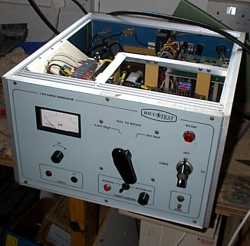
 Fun with
a surge generator
Fun with
a surge generator
See also the Destruct-o-tron
I recently picked up this Biccotest T219 surge generator very cheaply (£15) at an auction. It contains four 30 uF 6KV capacitors (centre) plus a charging circuit and discharge switch (right), and is switchable to produce discharges of 5KV from 30uF or 2.5KV from 120uF.
I thought it might be fun to see how various objects stood up to these discharges....
Initial experiments : Erasing Eproms - Permanently!
Bringing new meaning to the expression 'blowing eproms'... below 1KV, every eprom becomes a 'flash' device - at higher powers, the ceramic package splits open.


Plastic packages usually break into several pieces - these two just about held together

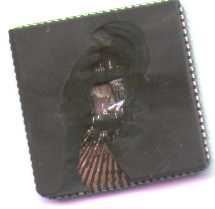
Exploding water
I wondered what would happen if I discharged a few KV through a small amount of water. I put a few mm in a plastic film can and dipped the electrodes in. At 2.5KV, nothing happened, but at 4.5KV, it made a hell of a flash & bang (see UK Winter 99 Teslathon page for some AVIs with sound).
Phase 1 mods - Can crushing & ballistic maglev
I've now bypassed the two 0.25 ohm current-limiting resistors, and replaced some of the
feeble internal wiring with nice heavy 6mm2 wire. I also put some foam rubber
around the discharge contacts to reduce the volume of the bang.
Discharging 2.5KV from 120uF through the coil shown below left will just about crush
aluminium drink cans (below centre). Part of the bang heard when doing this is due to the
air being forced out of the can - you can easily feel the blast of this if you hold your
hand a foot away from the open end of the can, and it is very noticeably louder than the
bang from the contact gap alone when there's no can inside the coil.
It has been suggested that objects reach supersonic speeds when crushing/shrinking - any
thoughts on how one might measure this would be welcome - remember that any
conductive object near the coil will be in an extremely electromagnetically hostile
environment, so optical sensing techniques would probably be necessary. Placing a sheet of
aluminium foil on a plastic sheet above the coil produces an extremely sharp snapping
sound. I wouldn't be surprised if this was producing a supersonic shock wave - does anyone
have any thoughts on how I might prove this - are there any simple observations that could
be made of effects peculiar to supersonic shockwaves ?
Update (Oct 98) : I used a crude laser and fibre-optic setup to
estimate the speed that the surface of a can moves, by timing the delay between the can
surface un-blocking 2 parallel beams 2mm apart at right-angles to the axis of the can, and
came up with a figure of 20 metres/sec.
Some time ago I remember seeing a demonstration where an aluminium ring is levitated above a large coil of wire carrying AC. I put a sheet of plastic on top of the crushing coil, and placed the aluminium platter from an old 2.5" hard disc on top. at 1KV it jumped about a foot. At 2.5KV it flew up and nearly smashed the fluorescent light above! The disc also makes a nice 'ding' sound as it jumps. An aluminium can placed above the coil jumps about 3 feet in the air. Must get round to trying the platter outdoors sometime to see how high it goes!
I wondered what would happen if the disc wasn't allowed to move upwards, so I suspended it in the middle of the coil. the picture below right was the result of about 4 consecutive firings.
I tried shrinking a small coin - it got very hot but didn't change shape - not enough power!
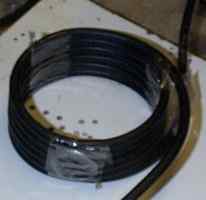

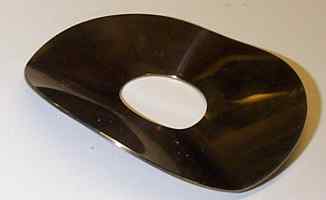
I tried some experiments shrinking rings of different sized conductors by placing them inside a 70mm coil of 7 turns. All started out as rings of approx. 65mm dia. Left to right : copper/tinned-copper wire soldered into a loop: 1mm, 1.5mm and 2.5mm dia., 12mm x 1.5mm flat braiding, 15mm section of 60mm thin-wall (0.6mm) aluminium boiler flue pipe.

The thinner wire illustrates the tendancy for the 'victim' to try to reduce its loop area - I occasionally saw figure-8 forms with thinner wire (when it didn't go flying across the room!). Another observation is that the lower resistance of thicker wire seems to compensate for the larger forces required to deform it - a lot of force is required to bend the 2.5mm ring by hand. I don't know if the wire is being temporarily softened by the heating effect (the thinner wire rings are too hot to touch afterwards). It would also be interesting to know if the heating was resistive, mechanical or a combination of both.
Encouraged by the results from the aluminium pipe above, I tried a larger section of the same stuff. (Left) placing the end of the pipe into the coil & firing once. (Right) A coil was tightly wound round the centre of the pipe and fired 3 times. The first firing only produced a slight distortion, due to the strength of the circular cross-section, but once this was broken down, the next 2 firings made a much more substantial impression.
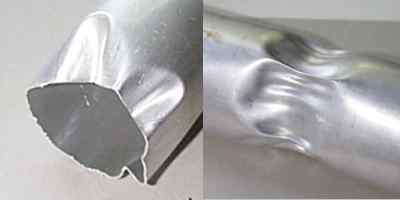
I tried discharging into the primary of a car ignition coil - the plastic insulation at the top broke down with a nice fat 40mm orange spark. Sometime I'll strip it out of the can and immerse it in oil to see how long a spark I can get!
Phase 2 mods - MORE POWER!
The next modification will be to do a complete strip-out and rewire - heavy busbars linking the caps, and modifying the charging circuit to charge the paralleled 120uF of caps to 5KV, quadrupling the discharge energy . I suspect more soundproofing of the discharge contacts will also be required!
There are some images and AVI movies of stuff being exploded with the capacitors from this surge generator on the UK Winter 99 Teslathon page.
NEW! The Destruct-O-Tron - More capacitors, More fun!
More info from people with bigger capacitors...
The Arcstarter's Capacitor RPI Plasma Dynamics Lab Can Crusher
Dr. Sprott's Can Crushing demo Bill Beatty's Dangerous Capacitor page Gary Weaver's HV page
Coin crushing on Bert Hickman's site
